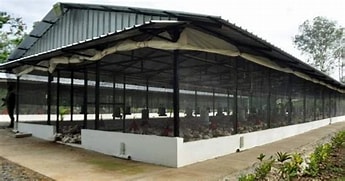5 Poultry Species That Will Boost Your Profits”
Introduction
Poultry farming is a lucrative business that can offer substantial profits when managed correctly. One key factor is selecting the right poultry species. Different breeds have unique characteristics that make them more suitable for specific types of farming, whether it’s for eggs, meat, or both. In this article, we’ll explore 5 Poultry Species That Will Boost Your Profits

1. Kuroiler: The Dual-Purpose Powerhouse

Overview of Kuroiler
The Kuroiler is a popular breed, especially in Africa and Asia. It’s known for its dual-purpose nature, excelling in both egg and meat production. Kuroilers are hardy, disease-resistant, and well-adapted to local climates.
Why Choose Kuroiler?
- High Egg Production: Kuroilers produce up to 200 eggs per year. This is impressive for a dual-purpose breed.
- Fast Growth Rate: Kuroilers grow quickly, reaching market weight in about 4-5 months. This fast growth rate allows for more production cycles.
- Low Feed Costs: Kuroilers are free-range birds, reducing the need for expensive commercial feed. This saves money and enhances the nutritional quality of their eggs and meat.
Benefits of Kuroiler
- Disease Resistance: Kuroilers are bred to be disease-resistant, reducing the need for expensive medications.
- Climate Adaptability: They thrive in various climates, making them suitable for different farming conditions.
- Easy to Manage: Kuroilers are friendly and easy to handle, which makes them ideal for backyard farms.
2. Rhode Island Red: The Egg-Laying Champion

Overview of Rhode Island Red
The Rhode Island Red is one of the most popular breeds for egg production. Known for their high productivity and friendly nature, these birds are a favorite among backyard farmers and commercial producers.
Why Choose Rhode Island Red?
- High Egg Yield: Rhode Island Reds produce an average of 200-220 brown eggs per year. Their high egg yield makes them an excellent choice for farmers.
- Hardiness and Adaptability: These birds are robust and adaptable to various climates, making them suitable for different farming conditions.
- Friendly Temperament: Rhode Island Reds are known for their friendly and docile nature, which makes them easier to handle and manage.
Benefits of Rhode Island Red
- Long Laying Period: Rhode Island Reds continue to lay eggs for many years, providing a steady income stream.
- Good Foragers: They are good foragers, which means they can thrive in free-range conditions, reducing feed costs.
- Easy to Care For: Their friendly nature makes them easy to care for, even for beginners.
3. Black Australorp: The Quiet Achiever

Overview of Black Australorp
The Black Australorp is another breed that excels in egg production. Originating from Australia, this breed is known for its high egg yield and quiet demeanor.
Why Choose Black Australorp?
- High Egg Production: Black Australorps produce an average of 200-250 large brown eggs per year. Their high productivity makes them a valuable asset for any poultry farm.
- Quiet and Docile: These birds are known for their calm nature, which makes them ideal for backyard farms where noise can be a concern.
- Good Foragers: Black Australorps are good foragers, which means they can thrive in free-range conditions, reducing feed costs and enhancing the quality of their eggs.
Benefits of Black Australorp
- Long Laying Period: Black Australorps continue to lay eggs for many years, providing a steady income stream.
- Low Maintenance: They are easy to manage and require minimal maintenance.
- High-Quality Eggs: Their eggs are large and of high quality, making them a favorite among consumers.
4. Sasso: The Meat Production Specialist
Overview of Sasso
The Sasso breed is a cross between a French breed and an African breed, designed specifically for meat production. Sasso chickens are known for their fast growth rate and high-quality meat.
Why Choose Sasso?
- Fast Growth Rate: Sasso chickens grow quickly, reaching market weight in about 5-6 weeks. This fast growth rate allows for multiple cycles of production.
- High-Quality Meat: Sasso chickens produce high-quality meat that is tender and flavorful. This makes them a favorite among consumers.
- Disease Resistance: Sasso chickens are bred to be disease-resistant, reducing the need for expensive medications.
Benefits of Sasso
- Efficient Feed Conversion: Sasso chickens convert feed into meat efficiently, reducing feed costs.
- High Demand: There is always a high demand for Sasso meat, making it easier to sell your products.
- Easy to Raise: Sasso chickens are easy to raise and manage, even for beginners.
5. Broiler Breeds: The Profitable Meat Producers
Overview of Broiler Breeds
Broiler breeds, such as the Cornish Cross, are specifically designed for meat production. These birds are known for their fast growth rate and high feed conversion efficiency.
Why Choose Broiler Breeds?
- Fast Growth Rate: Broiler breeds grow extremely quickly, reaching market weight in as little as 6-8 weeks. This fast growth rate allows for multiple cycles of production.
- High Feed Conversion Efficiency: Broilers convert feed into meat efficiently, reducing feed costs.
- High Demand: There is always a high demand for broiler meat, making it easier to sell your products.
Benefits of Broiler Breeds
- High Profitability: Broiler breeds can be highly profitable due to their fast growth rate and high demand.
- Efficient Production: They are designed for efficient production, allowing for multiple cycles of production in a year.
- Wide Market: Broiler meat has a wide market, making it easier to sell your products.
Effective Strategies for Maximizing Profit
Choose the Right Breed
Selecting the right breed is crucial. Each breed has unique characteristics, and choosing the right one based on your farming goals is essential. For example, if you’re looking to produce eggs, breeds like Rhode Island Red or Black Australorp would be ideal. For meat production, Sasso or broiler breeds are better options.
Optimal Housing and Free-Range System
Providing adequate housing that protects chickens from predators and harsh weather while allowing them to roam freely is essential. A well-structured free-range system offers several benefits, including improved health, a natural diet, and better product quality.
Efficient Feeding Practices
While free-ranging reduces feed costs, it’s important to supplement chickens’ diets with nutritious feed. A balanced diet that includes grains, proteins, vitamins, and minerals is essential. Fermenting feed can improve its nutritional value and reduce waste. Utilizing kitchen scraps and garden waste can also supplement their diet, but ensure it’s safe and free from harmful substances.
Health Management
Maintaining the health of your flock is vital for maximizing productivity and profit. Regular vaccination helps prevent common poultry diseases. Implementing biosecurity measures, such as cleaning and disinfecting the coop, can also help prevent the spread of diseases.
Marketing and Sales Strategies
Maximizing profit also involves smart marketing and sales strategies. Understanding your target market, whether it’s local consumers, restaurants, or farmers’ markets, is crucial. Developing a strong brand that highlights the benefits of your free-range, locally grown chickens can help you stand out. Diversifying your products, such as offering eggs, live birds, dressed chickens, and value-added products, can also increase revenue. Using social media and local online marketplaces to reach a broader audience and take orders is essential in today’s digital age.
Read This: Top 4 Countries with the Best Agricultural Systems
Conclusion
Maximizing profit in poultry farming requires a combination of good management practices, efficient resource use, and effective marketing strategies. By focusing on the right breed, housing, feeding, health management, and marketing, you can build a successful and profitable poultry farming business. Whether you’re starting small with a few Kuroilers or scaling up with broiler breeds, the key is to understand the unique strengths of each breed and leverage them to your advantage.
Meta Description
“Discover the top 5 poultry species to maximize profit in your farming business. Learn about Kuroiler, Rhode Island Red, Black Australorp, Sasso, and broiler breeds, and how to optimize their potential for higher earnings.”
Frequently Asked Questions
1. Is Chicken Farming Profitable?
Yes, chicken farming can be very profitable if managed correctly. It involves selecting the right breed, implementing efficient feeding practices, maintaining good health management, and using effective marketing strategies.
2. Which Poultry Farming is Most Profitable?
Layer chicken farming tends to be the most profitable in the long run because after laying eggs for a while, you can still sell the chickens as meat. However, broiler farming can also be highly profitable due to the fast growth rate and high demand for broiler meat.
3. How Do Poultry Farmers Make Money?
Poultry farmers make money from selling chicken eggs, day-old chicks, chicken meat, and even chicken manure. Some farmers also offer consultancy services to other poultry farmers.
4. How Many Chickens Do I Need to Make a Profit?
The number of chickens needed to make a profit depends on the demand in your area. With about 16 hybrid chickens, you can get up to 8 dozen eggs a week, but profitability also depends on feed costs, health management, and marketing strategies.
5. What Are the Key Factors in Maximizing Profit in Poultry Farming?
The key factors include selecting the right breed, providing optimal housing and free-range conditions, implementing efficient feeding practices, maintaining good health management, and using effective marketing and sales strategies.


